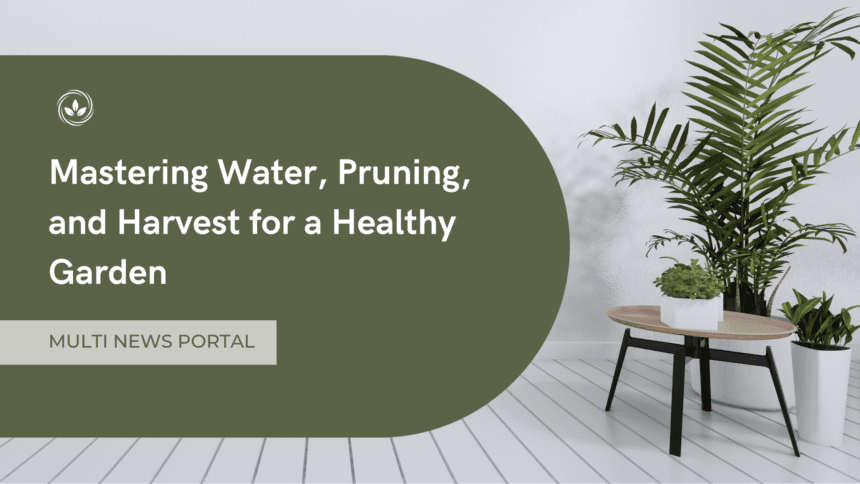Having a vibrant, productive garden requires mastering some key skills – knowing when and how much to water, pruning plants for optimal growth, and harvesting produce at just the right times. Read on for a comprehensive guide to essential gardening techniques for watering, pruning and harvesting your plants.
The Importance of Proper Watering
Watering is one of the most important factors in ensuring plants thrive. While specific needs vary between plant types, there are some general best practices to follow:
- Consistency – Stick to a regular watering schedule based on your climate and plant needs. Avoid underwatering or sporadic overwatering.
- Timing – The best time to water is early morning or late afternoon/evening. This allows absorption and reduces evaporation loss compared to midday.
- Soil considerations – Sandy soils require more frequent watering than clay soils which retain moisture better. Check soil an inch below the surface to gauge true moisture level.
- Add mulch – A 2-3 inch layer of mulch around plants helps regulate soil temperature and retain moisture so less water is required.
- Watering method – For individual plants, watering cans or directed hoses at the root zone ensure water absorption. For larger areas, sprinklers or drip irrigation deliver consistent coverage.
- Plant-specific needs – Some plants like tomatoes, zucchini, and peppers need consistent moisture and frequent watering, while others like succulents and lavender require far less.
Gaining an understanding of your specific garden’s soil, sun exposure and plant types will allow you to develop an optimal watering plan.

Pruning Plants for Improved Growth
Pruning is an important gardening skill that involves selectively removing parts of a plant to shape it and improve productivity. Here are key pruning tips:
- Dead or diseased branches should always be pruned out first to prevent spread and encourage new growth.
- Cross-over branches that rub or grow into each other should be pruned to improve air circulation.
- Prune just above a healthy outward-facing bud at a 45-degree angle to direct new growth. Avoid truncating branches.
- Spring bloomers should be pruned soon after flowering is complete for the current season.
- Don’t over-prune – take out only the necessary branches according to the plant’s pruning needs.
- Sterilize tools – wipe pruning shears with bleach or alcohol between plants to prevent transmitting diseases.
- Remove inward-facing branches to open up the plant’s shape and productivity.
Proper pruning encourages shapely, vibrant plants and can dramatically boost flowering and fruit yields if done consistently.
Harvest Produce at Its Peak
Knowing when and how to harvest your vegetables, herbs and other plants is key to flavor and productivity:
- Harvest most produce like tomatoes, peppers, beans, etc at peak ripeness for full flavor and nutrition.
- Plants like cucumbers and zucchini benefit from frequent partial harvests to encourage more production.
- Use clean, sterilized pruners or garden shears to carefully snip produce from the plant. Avoid yanking or twisting.
- Handle ripe produce very gently to prevent bruising – especially fruits like tomatoes.
- For best flavor, harvest in the cooler morning hours when plants are well hydrated.
- After harvest, store properly through canning, refrigeration, or freezing to extend shelf life.
Timing is everything when it comes to harvest. Pay close attention as crops near maturity and be ready to pick at their prime!
Conclusion
Watering, pruning, and harvesting are fundamental gardening skills any plant owner needs to learn. While it takes practice to perfect techniques, mastering these basics will allow you to have a prolific, beautiful, and bountiful garden. Be attentive to your plants, stick to a schedule, and continually refine your methods. Your plants will thrive under your care!
Frequently Asked Questions
How often should I water my vegetable garden?
Most vegetable gardens need about 1-2 inches of water per week, either through rainfall or manual watering. Check soil moisture daily and water when the top inch becomes dry. Increase frequency during hot, dry weather.
When should I not prune plants?
Avoid pruning just before or during the main flowering periods of spring bloomers like lilacs and forsythia. Also, don’t prune when plants are fully dormant in winter or stressed by drought.
What are signs that produce is ready for harvest?
Indicators like full size/shape, vibrant color, aromatic smell, easily detached from the plant, and perforated skin all signal ripeness and prime harvest time.
Can I harvest vegetables early?
It’s best to allow vegetables to fully ripen on the plant for ideal flavor and nutrition content. However, many can be harvested a few days early if an urgent need arises. Just expect a milder taste and texture.
How long do harvested vegetables last?
Properly stored, many harvested veggies last 1-2 weeks if kept cool and dry. Exceptions like peas and greens have a shorter shelf life of just 2-3 days. Canning, freezing, or fermenting extends storage life considerably.
Gaining competence with watering, pruning, and harvesting techniques will keep your garden healthy and let you enjoy its bounty. With a bit of hands-on practice, you’ll quickly master these essential gardening skills.









